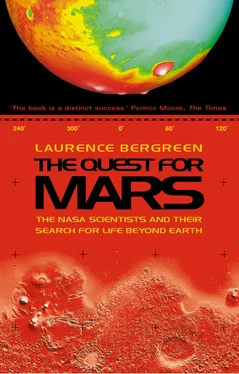Why do they do it? Why do these driven scientists, who could be earning several times more than their current salaries in private industry, stick with stingy old NASA? Why do they remain oblivious to imploring spouses and former colleagues who have gone to seek their fortunes in private industry? The most these NASA scientists can reasonably hope for is recognition from their peers, if they make a major discovery. They’ll have an easier time getting grants, lots of impressive plaques to hang on the wall, and that’s about it. Despite the influence of their ideas on the course of science and exploration, obscurity is often their lot. Who can name the members of the team that in 1996 announced possible evidence of fossilized life in a Martian meteorite – a discovery that, if correct, will stand as one of the most significant breakthroughs of all time? Who can name any NASA-supported scientist, for that matter, with the possible exception of Carl Sagan? And who, outside of the scientific community, is aware of Sagan’s actual role in NASA’s exploration of space?
Sagan’s success as a popularizer of the Cosmos obscures his real achievements as a scientist, thinker, and writer. A productive scientist and winner of the Pulitzer Prize, he frequently appeared on The Tonight Show ; he didn’t fit into neat categories. He was cursed with charisma. An astronomer by training, he gave a convincing impression of being at home with a number of disciplines ranging from mathematics to history. His fascination with space offered reassurance rather than terror of the unknown. He developed a benign, Jeffersonian vision of the universe as the last frontier, the ultimate, infinite West, where humanity would be able to seek refuge after fouling this planet and possibly destroying itself in the process. Sagan’s outer space, like Thomas Jefferson’s West, offered sufficient scope to alleviate humanity’s ills. He was pessimistic about the future of mankind if we were confined to Earth for too long. It seemed to him a near certainty that, sooner or later, we would blow ourselves up. The only escape from his Malthusian nihilism was the vastness of space and the promise of distant planets, where humankind could start anew. This vision of space as the new frontier influenced NASA from its inception, imparting a sense of purpose, and it inspired younger scientists by giving them a larger context for their research. In the midst of bureaucratic setbacks and budget battles, Sagan knew what was at stake in the exploration of space: over the short term, enlightenment, over the long term, the survival of humanity.
Throughout his career, he cultivated a special fascination with Mars. For him, it was a touchstone of all heavenly bodies and possibly the salvation of humanity. He wrote about it for scientists and for general readers, artfully mixing speculation and scientific fact. He prodded NASA to explore. And he held out hope for life on Mars. As early as 1966, when the conventional wisdom in the scientific community, chastened by the barren photographs resulting from the Mariner missions, held the chance of life on Mars to be zero, Sagan, almost alone among prominent scientists, speculated that such a phenomenon might still be possible.
Sagan influenced a generation of younger scientists, who have their hands on the levers of the future and who fervently believe that now is their time to change scientific thinking about the nature of the universe and our place in it. They stick with their work for many reasons: because they can’t do without it; because NASA gives them the means to do what they’ve yearned for since they were children growing up in the heyday of the space race, watching John Glenn go into orbit; because NASA will let them send something of their own design – a part of them – into space; because NASA has the rockets and the launch facilities and the infrastructure to get it done; because NASA will validate their work in the eyes of the scientific community and the world. Because, when it comes to planetary exploration, NASA is the only game in town.
The little airport on Heimaey is deserted; the Iceland Coast Guard helicopter has yet to arrive. Oscar sits at a table in an empty café, smoking a cigarette. Jim, wired, munches on a Mars bar (“It’s my planet, Larry. I may as well”) and reminds me that twenty-five years ago, this quaint little island (“Heimaey” means “Home Island”) had to be evacuated when that volcano – over there – erupted, and lava poured down its slopes into the village. When the eruption ended, Eldfell, as the volcano is known, had transformed the island. It was fifteen percent larger and contained thirty million additional tons of lava, which the local populace later used for roads and buildings. Nor was that eruption unusual for Iceland. Every five years, Iceland witnesses a major volcanic eruption, some capable of sending enough ash into the atmosphere to darken the hemisphere’s skies and lower global temperatures. In 1783, the largest volcanic eruption observed in modern times occurred in Iceland. It lasted for months and disgorged over two hundred square miles of lava. The explosion hurled sulfur dioxide particles into the lower atmosphere; they in turn caused acid rain that polluted the ground, poisoned cattle, starved a quarter of Iceland’s population, and darkened the skies over Europe. (A natural catastrophe of that magnitude has undoubtedly occurred on Mars.) Iceland is overdue for another eruption, Jim remarks casually, and an active volcano dominates the island where we will spend the day. The island’s name is Surtsey.
The newest place on Earth, Surtsey is even more Mars-like than the rest of Iceland. It was formed in a mammoth undersea volcanic eruption that lasted from 1963 until 1967 and, during its early phases, lit up the night skies for miles around. It was named for Surtur, the fire-bearing giant of Norse mythology. The island is younger than Jim, who was seven years old when it erupted into being. At the time, his family was living in Beirut, where his father worked for IBM. Jim’s maternal grandmother, who was living with them, became fascinated by the eruption. She collected all the newspaper clippings about it she could find and showed them to her grandson, giving an unexpected direction to his life. Jim has remained in Surtsey’s thrall ever since. The vanity plates on his ten-year-old Jeep announce, “SURTSEY.”
Only a couple of hundred people have ever set foot on the island. Access is extremely difficult. The North Atlantic currents surrounding it are too rough for most boats to negotiate; swells around the island are frequently twenty feet; waves have been said to reach eighty feet. The island is off limits to everyone but a few heavily credentialed scientists who have obtained permission from the Icelandic government to conduct research there on a “non-biologically interfering basis.” In practice, this restriction has made Surtsey into one of the largest and most carefully studied natural laboratories on the face of the Earth, of interest to geologists because of its recent, well-documented formation; to botanists and biologists, who track the development of life; and to Marsists like Jim Garvin who regard a visit to Surtsey as the closest they’ll ever come to the Red Planet.
The only practical way to reach the island is by helicopter, weather permitting. “There are no guarantees, as helicopters only go out that far once a month,” Jim alerted me several weeks earlier, when we were starting to get serious about the field trip. “Please note there are NO insurance provisions. ANYONE going to Surtsey does so at his or her own risk, and there is some, as the island is still HOT and there are hydrothermal systems with 120° C water just beneath the ground. Also, the weather can change, and people have been stranded. I was urged to remind you of this. Also, what I must do out there will require vigorous hiking over lava and volcanic ash. Anyway, there is a chance we will get there for a day that I do believe you will thoroughly enjoy.”
Читать дальше












